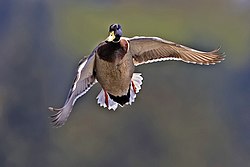尾端骨類 (びたんこつるい、Pygostylia) は、鳥翼類に属する恐竜の一群である。
定義
尾端骨類という分類群は、始祖鳥のようなより原始的な種の長くて融合していない尾とは対照的に、短くずんぐりした尾を持つすべての鳥群を包むことを目的としていた。これは1997年にSankar Chatterjeeによって命名された[2]。ルイス・キアッペは後に尾端骨類を節に基づく分岐群、「孔子鳥科 (Confuciusornithidae) と今鳥亜綱 (Neornithes) の共通祖先とそのすべての子孫」と定義した[3][4]。2001年、ジャック・ゴーティエとケビン・デ・ケイロスは、キアッペの節に基づく定義の代わりに、チャタジーの元の共有派生形質に基づく系統群の概念を使用することを推奨したが[5] 、この推奨は一貫して守られていない。ルイス・キアッペと共著者は引き続きキアッペの定義を使用しており、多くの場合、名前の著者はチャタジーではなく、キアッペ 2001[6]またはキアッペ 2002[7]に基づいている。
脚注
- ^ Chatterjee, S. 1997. The Rise of Birds. Baltimore: Johns Hopkins University Press. 312 pp.
- ^ Chiappe, Luis (2001). Chiappe, Luis; Witmer. eds. Basal bird phylogeny in Mesozoic Birds: above the heads of dinosaurs. University of California Press
- ^ Chiappe, L. (1997). “The Chinese early bird Confuciusornis and the paraphyletic status of Sauriurae”. Journal of Vertebrate Paleontology 17 (3): 37A. doi:10.1080/02724634.1997.10011028.
- ^ Gauthier, J., & De Queiroz, K. (2001). Feathered dinosaurs, flying dinosaurs, crown dinosaurs, and the name" Aves. New perspectives on the origin and early evolution of birds, 7-41.
- ^ Gao, C.; Chiappe, L. M.; Zhang, F.; Pomeroy, D. L.; Shen, C.; Chinsamy, A.; Walsh, M. O. (2012). “A subadult specimen of the Early Cretaceous birdSapeornis chaoyangensisand a taxonomic reassessment of sapeornithids”. Journal of Vertebrate Paleontology 32 (5): 1103. doi:10.1080/02724634.2012.693865.
- ^ O’Connor, J. K.; Zhang, Y.; Chiappe, L. M.; Meng, Q.; Quanguo, L.; Di, L. (2013). “A new enantiornithine from the Yixian Formation with the first recognized avian enamel specialization”. Journal of Vertebrate Paleontology 33: 1–12. doi:10.1080/02724634.2012.719176.
出典
